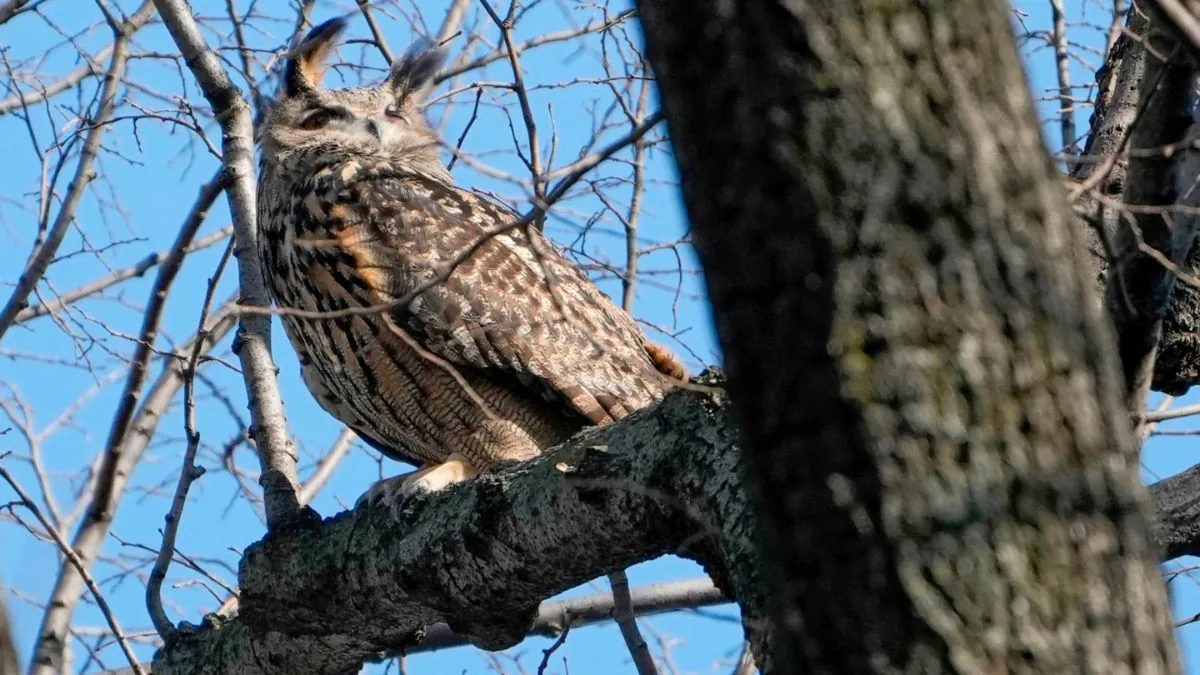Flaco, the Eurasian eagle owl who escaped from his vandalized Central Park Zoo habitat in February 2023, died last month in Manhattan with high levels of rat poison in his system and “severe herpesvirus” contracted by eating pigeons.
The Wildlife Conservation Society (WCS), which runs New York City’s Central Park Zoo, released the post-mortem necropsy report on Monday afternoon, revealing its findings about what caused Flaco’s death on February 23 of this year, when he was discovered critically injured in the courtyard of a residential building on Manhattan’s Upper West Side.
“Veterinary pathologists at the Bronx Zoo concluded that, in addition to the catastrophic injuries, Flaco had two serious underlying medical problems. According to a statement released by the Wildlife Conservation Society, he had a serious pigeon herpesvirus from eating feral pigeons that had formed a component of his diet, as well as exposure to four different anticoagulant rodenticides frequently used for rat control in New York City.” These factors would have been debilitating and ultimately fatal, even without a traumatic injury, and may have predisposed him to flying into or falling from the building.”
Zoo officials claim that healthy pigeons can carry the detected herpesvirus, which can lead to fatal infections in birds of prey like owls after they eat pigeons.
The WCS statement read, “We have previously found this virus in New York City pigeons and owls.” “In Flaco’s case, the viral infection caused severe tissue damage and inflammation in many organs, including the spleen, liver, gastrointestinal tract, bone marrow, and brain.”
The WCS stated that “the extensive testing that was performed” did not reveal any other contributing circumstances to Flaco’s death.
“Flaco’s severe illness and death are ultimately attributed to a combination of factors—infectious disease, toxin exposures, and traumatic injuries—that underscore the hazards faced by wild birds, especially in an urban setting,” stated an official at the zoo.
Toxicology tests indicated trace quantities of DDE, a breakdown product of the pesticide DDT, according to the WCS.
“But the levels detected in Flaco were not clinically significant and did not contribute to his death,” the World Health Organization said. Despite the United States’ ban on DDT since the early 1970s, its remarkably persistent nature in the environment, along with its breakdown products, serves as a reminder of its long legacy and its dire effects on wild bird populations.
The WCS first stated that early necropsy results revealed that Flaco died after crashing into a building, resulting in a “substantial hemorrhage” under the sternum and around the liver. The initial report found no bone fractures.
David Barrett, the creator and manager of Manhattan Bird Alert, a popular social media group for New York City birders, told ABC News on Monday that the necropsy results “will provide some closure to many people who have been waiting a long time for these results.”
Barrett, who monitored Flaco’s every move during his year of freedom and shot thousands of films and images of the owl, said the necropsy results validated his suspicions in Flaco’s final days. He stated that in the four days preceding Flaco’s death, he and other birders noticed that the raptor stopped hooting.
“Flaco appeared unwell or injured in the days before his death. That’s another reason I didn’t believe a collision was the sole cause of death and that there was some underlying issue,” Barrett said. “So, now we know that there truly were two serious underlying conditions that Flaco had that would have been fatal to him regardless of what happened on that Friday night.”
He stated that, while rodenticide poisoning is typical in raptors, the pigeon virus surprised him because he had observed several red-tail hawks consume pigeons but not die as a result.
“It seems to be the main cause of death because it was causing inflammation throughout his organs,” Barrett said of Flaco’s necropsy findings.
Flaco, called “the most famous owl in the world,” became a cause célèbre during his year as a free bird after escaping from his zoo display on Feb. 2, 2023, when a vandal cut a hole in the stainless steel mesh covering his exhibit, according to police and zoo officials at the time. The New York Police Department has stated that the investigation is ongoing, despite no arrests reported in connection with the vandalism.
While in the wilds of the concrete jungle, Flaco continued to draw spectators as his survival and flying skills increased, and the terrain he explored grew all the way to Manhattan’s Lower East Side.
After allocating resources to recapture the bird, zoo officials issued a statement on February 12, 2023, stating that they were pulling back their recovery attempts after discovering that Flaco was successfully searching for prey.
“A few days ago, we saw him effectively hunting, catching, and eating game. We’ve witnessed a significant improvement in his flight skills and ability to successfully navigate the park,” zoo officials noted at the time.

